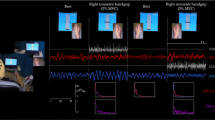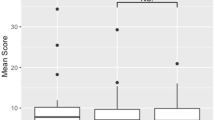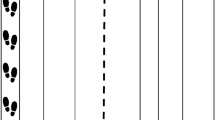Abstract
Kinematic and functional magnetic resonance imaging were combined to investigate how movement complexity (in-phase vs. anti-phase) and rate (maximum rate vs. 1 Hz) influence the brain sensorimotor network of relapsing- remitting fatigued (F) and notfatigued (NF) MS patients during the performance of coordinated hand and foot movements.
Kinematic measures did not differ between F and NF patients. Task and disease showed an interaction in the right precuneus and posterior lobe of the cerebellum during in-phase/anti-phase conditions and in the right precuneus and posterior and anterior lobes of the cerebellum during maximum vs. 1 Hz rate. Task, disease and fatigue showed an interaction in the right precentral gyrus, the left postcentral gyrus, the left SII, the right precuneus, the right basal ganglia, the left lingual gyrus, and the posterior lobe of the cerebellum, bilaterally, during in-phase/ anti-phase conditions and the left postcentral gyrus, the left SII, the right anterior lobe of the cerebellum, and the posterior lobe of the cerebellum, bilaterally during maximum vs. 1 Hz rate.
Investigations of motor task performance in MS patients require careful control of several variables, including task complexity, movement rate, and the presence of “subtle” clinical disturbances, such as fatigue, which might be underestimated at a standard neurological assessment.
Similar content being viewed by others
References
Augustine JR (1996) Circuitry and functional aspects of the insular lobe in primates including humans. Brain Res Brain Res Rev 22:229–244 (Review)
Baldissera F, Cavallari P, Civaschi P (1982) Preferential coupling between voluntary movements of ipsilateral limbs. Neurosci Lett 34:95–100
Baldissera F, Cavallari P, Leocani L (1998) Cyclic modulation of the Hreflex in a wrist flexor during rhythmic flexion-extension movements of the ipsilateral foot. Exp Brain Res 118:427–430
Baldissera F, Cavallari P, Marini G, Tassone G (1991) Differential control of in-phase and anti-phase coupling of rhythmic movements of ipsilateral hand and foot. Exp Brain Res 83:375–380
Colier WNJM, Quaresima V, Oeseburg B, Ferrari M (1999) Human motorcortex oxygenation changes induced by cyclic coupled movements of hand and foot. Exp Brain Res 129:457–461
Debaere F, Swinnen SP, Beatse E, Sunaert S, Van Hecke P, Duysens J (2001) Brain areas involved in interlimb coordination: a distributed network. NeuroImage 14:947–958
Ehrsson HH, Naito E, Geyer S, Amunts K, Zilles K, Forssberg H, Roland PE (2000) Simultaneous movements of upper and lower limbs are coordinated by motor representations that are shared by both limbs: a PET study. Eur J Neurosci 12:3385–3398
Filippi M, Rocca MA, Colombo B, Falini A, Codella M, Scotti G, Comi G (2002) Functional magnetic resonance imaging correlates of fatigue in multiple sclerosis. NeuroImage 15:559–567
Filippi M, Rocca MA, Mezzapesa DM, Ghezzi A, Falini A, Martinelli V, Scotti G, Comi G (2004) Simple and complex movement-associated functional MRI changes in patients at presentation with clinically isolated syndromes suggestive of multiple sclerosis. Hum Brain Mapp 21:108–117
Rocca MA, Filippi M (2007) Functional MRI in multiple sclerosis. J Neuroimaging 17:36S–41S (Review)
Hadjikhani N, Roland PE (1998) Crossmodal transfer of information between the tactile and the visual representations in the human brain: A positron emission tomographic study. J Neurosci 18:1072–1084
Hanakawa T, Immisch I, Toma K, Dimyan MA, Van Gelderen P, Hallett M (2003) Functional properties of brain areas associated with motor execution and imagery. J Neurophysiol 89:989–1002
Harrington DL, Haaland KY, Knight RT (1998) Cortical networks underlying mechanisms of time perception. J Neurosi 18:1085–1095
Hoover JE, Strick PL (1999) The organization of cerebellar and basal ganglia outputs to primary motor cortex as revealed by retrograde transneuronal transport of herpes simplex virus type 1. J Neurosci 19:1446–1463
Jancke L, Specht K, Mirzazade S, Peters M (1999) The effect of finger-movement speed of the dominant and the subdominant hand on cerebellar activation: A functional magnetic resonance imaging study. NeuroImage 9:497–507
Krupp LB, La Rocca NG, Muir-Nash J, Steinberg AD (1989) The fatigue severity scale. Application to patients with multiple sclerosis and systemic lupus erythematosus. Arch Neurol 46:1121–1123
Kurtzke JF (1983) Rating neurological impairment in multiple sclerosis: en expanded disability status scale (EDSS). Neurology 33:1444–1452
Leocani L, Colombo B, Magnani G, Martinelli-Boneschi F, Cursi M, Rossi P, Martinelli V, Comi G (2001) Fatigue in multiple sclerosis is associated with abnormal cortical activation to voluntary movement-EEG evidence. Neuro- Image 13:1186–1192
Lutz K, Specht K, Shah NJ, Jancke L (2000) Tapping movements according to regular and irregular visual timing signals investigated with fMRI. Neuroreport 11:1301–1306
Montgomery SA, Asberg M (1979) A new depression scale designed to be sensitive to change. Br J Psychiatry 134:382–389
Oldfield RC (1971) The assessment and analysis of handedness: the Edinburgh Inventory. Neuropsychologia 9:97–113
Pantano P, Mainero C, Caramia F (2006) Functional brain reorganization in multiple sclerosis: evidence from fMRI studies. J Neuroimaging 16: 104–114 (Review)
Parent A, Hazrati LN (1995) Functional anatomy of the basal ganglia. I. The cortico-basal ganglia-thalamo-cortical loop. Brain Res Brain Res Rev 20:91–127 (Review)
Polman CH, Reingold SC, Edan G, Filippi M, Hartung HP, Kappos L, Lublin FD, Metz LM, McFarland HF, O’Connor PW, Sandberg-Wollheim M, Thompson AJ, Weinshenker BG, Wolinsky JS (2005) Diagnostic criteria for multiple sclerosis: 2005 revisions to the “McDonald Criteria”. Ann Neurol 58:840–846 (Review)
Ramnani N, Passingham RE (2001) Changes in the human brain during rhythm learning. J Cogn Neurosi 13:952–966
Rizzolatti G, Fogassi L, Gallese V (1997) Parietal cortex: from sight to action. Curr Opin Neurobiol 7:562–567 (Review)
Rocca MA, Agosta F, Colombo B, Mezzapesa DM, Falini A, Comi G, Filippi M (2007) fMRI changes in relapsing- remitting multiple sclerosis patients complaining of fatigue after IFNbeta-1a injection. Hum Brain Mapp 28:373–382
Rocca MA, Falini A, Colombo B, Scotti G, Comi G, Filippi M (2002) Adaptive functional changes in the cerebral cortex of patients with non-disabling MS correlate with the extent of brain structural damage. Ann Neurol 51:330–339
Rocca MA, Gatti R, Agosta F, Tortorella P, Riboldi E, Broglia P, Filippi M (2007) Influence of body segment position during in-phase and antiphase hand and foot movements: a kinematic and functional MRI study. Hum Brain Mapp 28:218–227
Rocca MA, Matthews PM, Caputo D, Ghezzi A, Falini A, Scotti G, Comi G, Filippi M (2002) Evidence for widespread movement-associated functional MRI changes in patients with PPMS. Neurology 58:866–872
Roelcke U, Kappos L, Lechner-Scott J, Brunnschweiler H, Huber S, Ammann W, Plohmann A, Dellas S, Maguire RP, Missimer J, Radu EW, Steck A, Leenders KL (1997) Reduced glucose metabolism in the frontal cortex and basal ganglia of multiple sclerosis patients with fatigue: a 18F-fluorodeoxyglucose positron emission tomography study. Neurology 48:1566–1571
Sadato N, Ibanez V, Deiber MP, Campbell G, Leonardo M, Hallett M (1996) Frequency-dependent changes of regional cerebral blood flow during finger movements. J Cereb Blood Flow Metab 16:23–33
Sandroni P, Walker C, Starr A (1992) ‘Fatigue’ in patients with multiple sclerosis. Motor pathway conduction and event-related potentials. Arch Neurol 49:517–524
Schmahmann JD, Pandya DN (1995) Prefrontal cortex projections to the basilar pons in rhesus monkey: implications for the cerebellar contribution to higher function. Neurosci Lett 199:175–178
Sheean GL, Murray NM, Rothwell JC, Miller DH, Thompson AJ (1997) An electrophysiological study of the mechanism of fatigue in multiple sclerosis. Brain 120:299–315
Smith SM, Zhang Y, Jenkinson M, Chen J, Matthews PM, Federico A, De Stefano N (2002) Accurate, robust, and automated longitudinal and cross-sectional brain change analysis. NeuroImage 17:479–489
Tartaglia MC, Narayanan S, Francis SJ, Santos AC, De Stefano N, Lapierre Y, Arnold DL (2004) The relationship between diffuse axonal damage and fatigue in multiple sclerosis. Arch Neurol 61:201–207
Wenderoth N, Debaere F, Sunaert S, Swinnen SP (2005) The role of anterior cingulate cortex and precuneus in the coordination of motor behaviour. Eur J Neurosci 22:235–246
Worsley KJ, Friston KJ (1995) Analysis of fMRI time-series revisited – again. NeuroImage 2:173–181
Author information
Authors and Affiliations
Corresponding author
Rights and permissions
About this article
Cite this article
Rocca, M.A., Gatti, R., Agosta, F. et al. Influence of task complexity during coordinated hand and foot movements in MS patients with and without fatigue. J Neurol 256, 470–482 (2009). https://doi.org/10.1007/s00415-009-0116-y
Received:
Revised:
Accepted:
Published:
Issue Date:
DOI: https://doi.org/10.1007/s00415-009-0116-y




